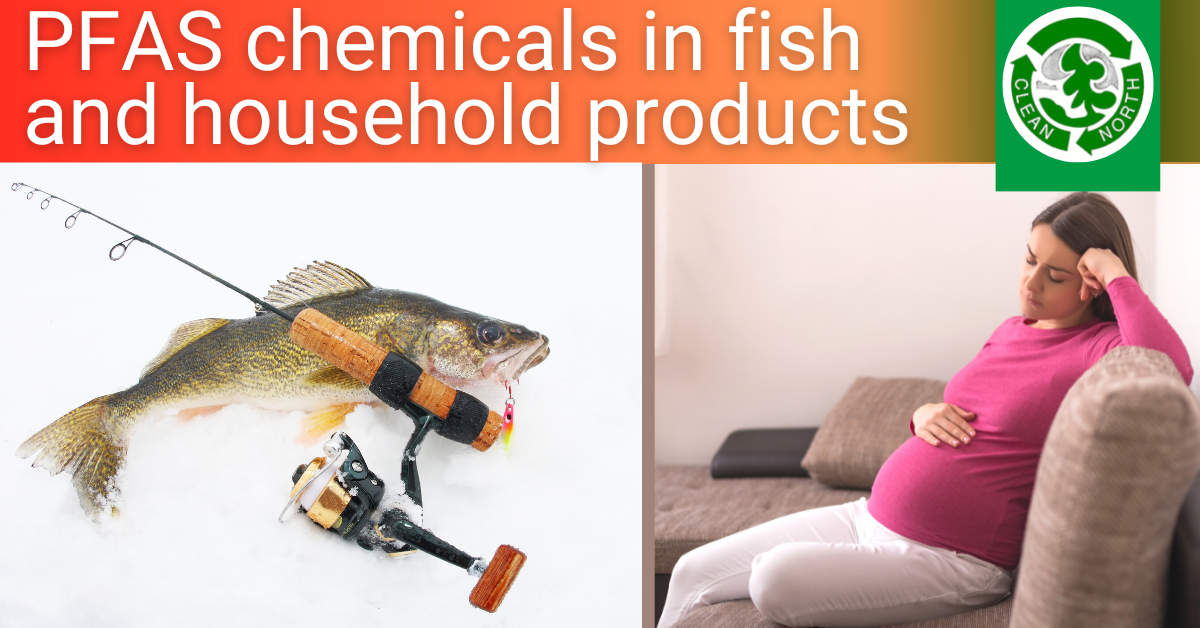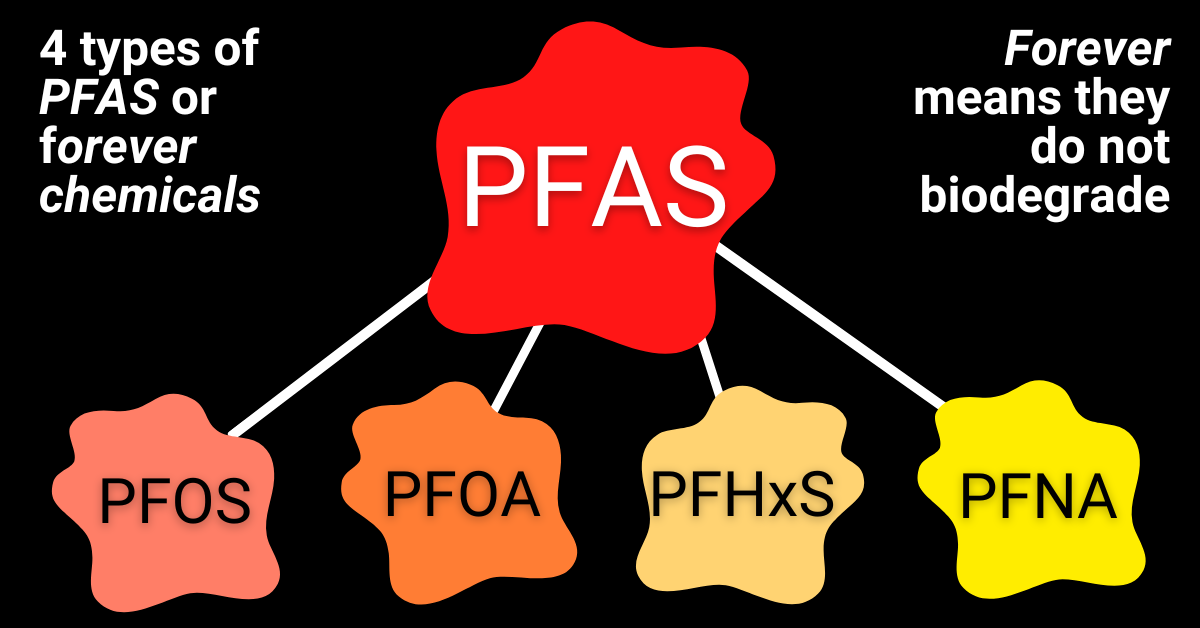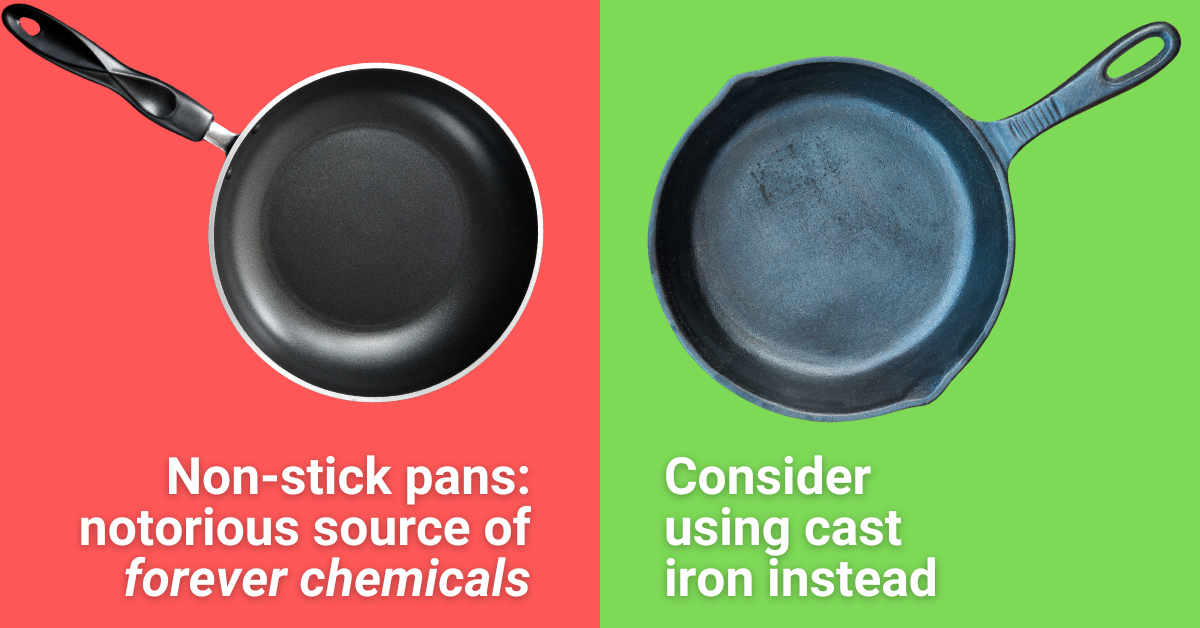
Most of us would never drink a cup of carpet stain protector! Yet eating a single serving of freshwater fish could expose us to dangerously high level of PFAS, “forever” chemicals used in stain protectors and other products. So it’s probably wise to limit how often we eat locally caught fish like smelt, lake whitefish and walleye. (For other ways we can reduce our exposure to these chemicals, scroll to the bottom of this page.)
What are PFAS?
Forever chemicals or PFAS (perfluoroalkyl and polyfluoroalkyl substances) are chemical compounds useful in manufacturing. The below graphic lists four, but there are actually thousands of them.

The up side of PFAS: They are incredibly stable and can repel oil, grease, water, and heat.
The down side: Because they are so stable, they persist in the environment and human/animal tissues for a very long time. They also move around easily in the air and in water.
We cannot see or taste these chemicals. But they are still there!
Where do PFAS come from?
Manufacturers began embracing PFAS chemicals in the 1950s because of how well they make products stain resistant, waterproof, or non-stick. Items that often contain PFAS include:
- Non-stick cookware
- Food packaging (such as pizza boxes, candy wrappers, microwave popcorn bags)
- Stain- or water-resistant fabrics (carpeting, upholstery, clothing)
- Personal care products (dental floss, shampoo, eye makeup, nail polish)
- Electronics
- Rubber and plastic
- Paints, sealants, varnishes
- Cleaning products
- Pesticides
- Fire-fighting foam
PFAS can end up in household dust and drinking water, even in remote locations like the Arctic.

Are these chemicals dangerous?
- Testicular, kidney, prostate and ovarian cancers
- Ulcerative colitis
- High cholesterol
- Pregnancy-induced hypertension
- Thyroid disruption
- Hormone changes
- Liver obesity
- Immunotoxicity
- Lower birth weight and size
- Delayed puberty
- Decreased fertility
- Early menopause
- Reduced testosterone
- Changes in bone density
Health Canada says that close to 100% of all Canadians have PFAS in their blood. It’s also been found in breast milk.
Something’s fishy with PFAS
So back to fish:
- Recent research results show that locally caught freshwater fish are a major source of exposure to PFOS in the United States. In fact, one serving of freshwater fish can be equivalent to an entire month of drinking PFOS-laced water at harmfully high levels.
- Canadian research has shown our freshwater fish also have high levels of forever chemicals.
- Great Lakes states are telling their residents to eat no more than one meal of smelt per month due to high levels of PFAS in these fish.
- Provincial guidelines for fish consumption are likely inadequate. For example, if you look at the fish consumption advisory for the St. Mary’s River, the only fish noted to have PFAS issues is rainbow smelt, likely due to the advisories across the border. However, it’s unlikely that only rainbow smelt have PFAS in them! They are small fish and get eaten by larger ones, in which forever chemicals accumulate over time.
Complicating things, some high-profile PFAS are monitored and studied, and some manufacturers have stopped using them, but many others are not even tracked. It’s a chemical game of Whack-A-Mole. One chemical goes out of favour but is replaced by a different one with similar properties and possibly similar risks.
People in equity-seeking groups are affected more
Research in the U.S. shows that low-income and Black and Brown people are more likely to live close to a site contaminated with PFAS.
High PFAS levels in freshwater fish can also disproportionately affect Indigenous peoples who view fishing as an important cultural practice and rely on fish as a staple food.
Being in a remote area is no guarantee of low PFAS levels. These chemicals are common in the Arctic, transported through atmospheric deposition.
“How can I reduce my exposure to forever chemicals?”
- Limit how much freshwater fish you eat.
- Test your drinking water and consider a filter.
- Avoid fast food restaurants and avoid reheating food in takeout containers.
- Avoid microwave popcorn.
- When buying furniture and clothing, find out if PFAS are being used in their manufacture. Avoid water- and stain-resistant products.
- Limit use of personal care products containing PFAS (including easy-glide dental floss). Learn more on the Environmental Working Group website.
- Choose cast-iron, stainless steel, aluminum, glass, or ceramic cookware rather than non-stick pans made with PFAS. If you have a non-stick pan, avoid using it on high heat and throw it away as soon as it becomes scratched.
- Use HEPA filters when vacuuming.
- Change furnace/air conditioner filters as recommended.
- Contact politicians and ask them to take action on protecting the environment and us from PFAS.
Read more on reducing PFAS exposure the Consumer Reports website.




